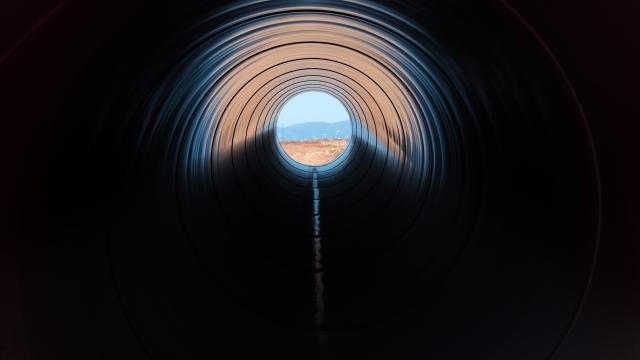
By now it’s safe to say that Tony Straquadine Jr. was destined for a career in the energy industry. His education and global experience bear that out. He has just finished his first year as executive director of the INGAA Foundation Inc. replacing the irrepressible Richard Hoffmann, who retired last year.
Before we discuss his role and plans with the foundation, we need to look at how Straquadine got into the oil and gas business in the first place?
“From an early age I was interested in the geology and geophysics side of things; I have a degree in both from the University of Hawaii,’’ he told Hart Energy. “My first interest was to return to Hawaii, and I knew I needed to build a career to get back there. My first job was in the Middle East on seismic exploration crews.
“That was my first foray into the upstream sector. What started as a two-year contract in Saudi Arabia for Geophysical Services Inc., the founding company for Texas Instruments, turned in to a six-year career development opportunity where I worked in seven Middle Eastern countries ending in Damascus, Syria as the operations manager running two seismic field crews.”
Geophysical Services Inc. was acquired by Halliburton, which sold that part of the business to then Western Geophysical.

By 2018, Straquadine had already been working for 19 years at Alliance Pipeline, the cross-border natural gas system between Canada and the U.S. which was nearing completion when he joined the fledgling company. Alliance took three years to complete and was the largest pipeline constructed in the 1990s. He was managing U.S. officer and manager of commercial and government affairs, responsible for directing and implementing government relations strategies in the U.S. and Canada—the perfect skill set for the high-profile Foundation position he assumed in September 2018.
Not Exactly A Stranger
“I served as a board member on the foundation for five years with Alliance, plus served one year as a board member of the Interstate Natural Gas Association of America (INGAA). This new role piqued my interest in serving both service providers and pipeline operating companies to ensure the foundation continues to fulfill its mission and vision. I believe it is important to build on previous executive directors’ successes: meeting members’ requirements and adapting to future industry needs.”
Straquadine is the first foundation leader from an operating company. He believes he provides a balanced perspective thanks to his early experience as an upstream service provider and his work with Alliance Pipeline. “I bring a pipeline operator focus, both from a policy perspective as well as the ongoing servant-leader commitment to pipeline safety and efficient operations.”
The INGAA Foundation recently celebrated its 30th anniversary at its fall conference in November. Its growth, from a mere dozen companies to nearly 230 today, has paralleled that of the industry.
“We’ve grown from a small trade association to a substantial organization that provides significant benefits to our members,” he said. “We focus on creating value through research studies, white papers and workshops that support both operators and service providers. The foundation’s work benefits the entire natural gas pipeline value chain.”
As the foundation has evolved, it has become more reliant on member subject matter experts to help identify strategic opportunities.
“The small size of our staff requires that we leverage our membership to develop the best ideas and to identify timely and impactful research that will aid in the safe, responsible development, operation and maintenance of natural gas transmission infrastructure.”
Internal Engagement Sought
Foundation members include both pipeline owner/operators and a diverse array of service providers including construction companies, engineering companies, consultants, small service providers, down to right-of-way clearing companies. Yet, they all share the same understandable concerns.
“Foundation members are focused on the success of pipeline operators and their ability to site pipe in a reasonable, predictable manner,’’ Straquadine said. “It is increasingly important for the foundation to mobilize the value chain represented by its members to support the pipeline industry on key public policy issues.”
In fact, Straquadine said it’s a topic discussed at every meeting. “It’s essential that we involve our membership in support of the pipeline operators’ strategic imperatives. We’ve taken steps to be even better aligned.”
A successful example of this alignment occurred in June, when the foundation hosted a Natural Gas Pipeline Technology Showcase on Capitol Hill to support the Pipeline Safety Reauthorization bill pending in Congress. Four leading inline inspection (ILI) companies that make “smart pigs” brought in demonstration tools to allow members of Congress, staff, regulators and the media to learn about these tools. Foundation Chairman Victor Gaglio of Duke Energy began the session.
“We’re working to create a higher profile by showcasing our members,” Straquadine said. “The pipeline operators typically don’t own ILI technology and contract it out. So, we brought in our key members to demonstrate how they use technology to inspect transmission pipelines. Pipeline operators from INGAA also participated in the event to explain why or when these tools are used, while the ILI operators demonstrated ‘here’s the technology, here’s our tools and examples of the data we collect for the operator.’
“One provider’s display included a cross-section of pipe it had inspected, linked to its data to show what the tool read so you can see a direct correlation between what’s known as a pipeline ‘feature’ on their data. By touching the pipe, you could identify the exact location of corrosion and wall loss.
“The June event is one example of how we’re going beyond our traditional role of sponsoring studies and workshops to bring the education directly to the elected officials and their advisors who write the laws that affect our industry.”
Public Perception
One study underway will address noteworthy issues reflecting responsible natural gas infrastructure developments. This fits in well with the times, as the pipeline industry faces unprecedented pushback against new development.
“We’ll build on our website,” America’s Energy Link, which provides industry information, details and blog posts that keep our industry and the public informed,” Straquadine said. “We’re reassessing how effectively these messages present the value of our industry, and whether we are reaching the right people.
“Our flagship study last May addressed the role of natural gas in the transition to a lower carbon economy. Those of us in the industry understand the value we deliver, but often times the public only receives soundbites about our industry, which can be riddled with incorrect or incomplete information. We hope that refining our messages will convey why new infrastructure is needed and why we believe we can continue to operate safely and respectfully within the communities where our projects exist.”
Pipeline Safety
Safety remains the foundation’s leading priority. Straquadine detailed how the organization is making changes to further enhance its safety efforts.
“One of our structural changes has been to create key standing committees comprised of Foundation members. We’ve always had a safety and quality committee. However, the executive committee wanted to achieve greater clarity of purpose. That was done by creating a stand-alone safety committee focused on personnel, asset-related safety and a new quality and integrity committee that will build on the pipeline industry’s commitments to integrity management.
“This adjustment aligns well with INGAA’s Integrity Management Continuous Improvement (IMCI) commitments. This committee is specifically focused on ensuring that we maintain the intense focus borne out of our industry’s initial IMCI commitments in 2011.
“We’ll be offering a Steep Slope Construction Best Practices workshop in Houston that will focus on the challenges of working in a steep slope environment,” he continued.
“We discovered that some stakeholders had questions about slips on slopes in recently constructed pipelines, so we thought it would be worthwhile to share best practices across the industry.”
Looking Ahead
With energy, pipelines and the environment looming as major issues for the 2020 elections, the foundation may find itself, out of need, to be more engaged in public policy discussions than in the past.
“While historically the foundation has not been a direct advocacy organization, there’s nothing that precludes us from doing so,” Straquadine said. “Part of our strategic alignment is to better understand where foundation members or the foundation on its own can help to influence the public policies that affect our business. Clearly, the success of our industry requires local, state, and federal support and recognition of our focus on ensuring safety; the value of the jobs we create (both direct and indirect) and the environmental benefits afforded by the use of natural gas.
“I don’t expect the foundation to be leading the charge from a political aspect, and we certainly won’t be endorsing any candidates. However, we must be prepared to deliver important messages at the right time and place, such as at our technology forums, that demonstrate our industry’s commitments to safety and the environment and our importance to the economy of our country.”
Several candidates for the Democratic presidential nomination have been particularly vocal in opposition to any new infrastructure or development. Straquadine suggested that these comments are really nothing new to the industry.
“Having been around the industry for 20-some years, much of that supporting advocacy, public outreach, or political engagement aspect, I don’t believe many of those comments are new. We will continue to advocate for our industry, explain what we do right, and describe the value we create—the jobs, and economic and environmental benefits. We look forward to working with all elected officials at the end of the day.”
